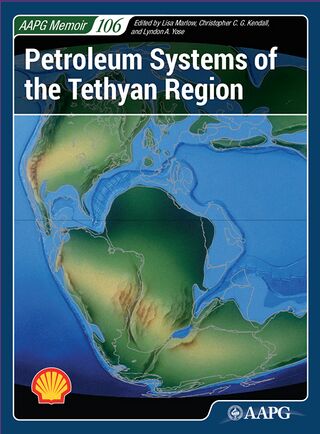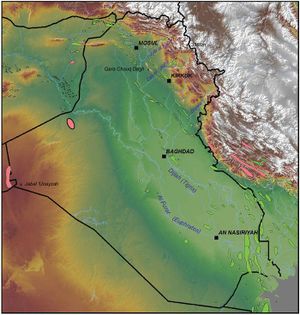Iraq petroleum geology
| Petroleum systems of the Tethyan region | |

| |
| Series | AAPG Memoir |
|---|---|
| Chapter | Iraq |
| Author | George J. Grabowski Jr. |
| Link | Web page |
| Store | AAPG Store |
There are more than 100 oil and gas fields in Iraq, containing more than 137 billion barrels of recoverable oil and more than 106 TCF of recoverable gas. Of this large resource, about 25 billion barrels of oil and 11 TCF of gas have been produced to date.
Introduction
Nearly all of the oil and gas occurs in fields located within the Mesopotamian foredeep, Gotnia Basin, and Zagros foldbelt. Minor discoveries and shows have been found on the Arabian platform along the western flank of the Mesopotamian foredeep. There is one gas discovery (Akkas field) on the Arabian platform in western Iraq.
Ninety-eight percent of the oil and gas occurs in reservoirs of Cenozoic and Cretaceous age. The largest reserves occur in: 1) carbonate rocks of the Kirkuk Group (Lower Miocene–Oligocene), in fields within the Zagros foldbelt of northeastern Iraq, the largest being Kirkuk field; 2) carbonate rocks of the Mishrif Formation (Turonian–Cenomanian), in fields within the Mesopotamian foredeep and Zagros foldbelt in southern and central Iraq, including Rumaila, West Qurna, Majnoon, Halfayah, Zubair, and Buzurgan fields; and 3) siliciclastic rocks of the Zubair Formation (Albian–Barremian), in fields within the Mesopotamian foredeep and Zagros foldbelt in southern and central Iraq, including East Baghdad, Rumaila, West Qurna, and Zubair fields. Large reserves also occur in carbonate rocks of the Upper Cretaceous above the Mishrif Formation and in the Lower Cretaceous below the Zubair Formation. Smaller reserves occur in other Neogene and Paleogene carbonates and siliciclastics, in Jurassic and Triassic carbonates, and in Ordovician siliciclastics.
Most of the oil and gas that have been discovered were generated from organic-rich, oil-prone carbonates of the Jurassic Sargelu and Naokelekan Formations. These source rocks are widely distributed and mature for oil and gas generation across the Mesopotamian foredeep and Zagros foldbelt. Lesser amounts of oil and gas are derived from: 1) Upper and Lower Cretaceous oil-prone source rocks within the Zagros foldbelt; 2) Triassic oil-prone source rocks in northwestern Iraq; and 3) Silurian gas-prone source rocks in western Iraq. The oil generated from the Jurassic source rocks migrated vertically to fill stacked reservoir intervals in many fields. Lateral migration of oil occurred along the western margin of the Mesopotamian foredeep, as proven by small fields and large seeps that are located where source rocks are absent or immature for oil or gas generation.
Physiography
The southern and western parts of Iraq are part of the broader Arabian platform of adjacent Syria, Jordan, Saudi Arabia, and Kuwait (Figure 1). This is a sparsely populated area of desert and low hills, mostly 300–500 m (984–1640 ft) above sea level (msl). The highest elevation here occurs at Jabal ‘Unayzah, in the southwestern corner of the country, at 940 msl. Bedrock is exposed in these areas, largely Cenozoic but Mesozoic and Paleozoic in western Iraq.
See also
- Phanerozoic Tethys region
- Israel petroleum systems
- Libya hydrocarbon provinces
- Tethys region
- Jordan petroleum geology
